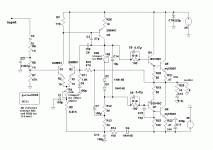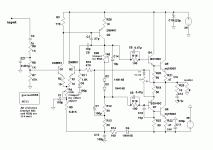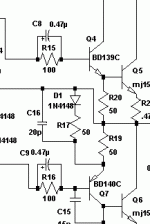Hello
Here's a simple quasi-complementary 50 watts amp that I've done. It's nice sounding and use easy to find parts.
You adjust the offset using R4, for minimum dc output. Adjust the R6 trimpot for 70ma of bias.
All capacitor should be rated at 50 volt. All resistors (except R21 and R22) are 1/4 watt. The resistors R21 and R22 are 5 watts.
It's a fairly simple amp to buid, you can do it using aerial copper wires to build it.
Use 4 amp fuses for each rail supply voltage inputs, it's good to put a 100 ohm 3 watt resistor across each of the fuse holder connections, this resistor will keep a voltage on the rail if only one side fuse blow.
Just be carefull NOT to put the input and vas transistors close to the output transistors or to the rails, and you need to use a star ground.
Don't use the BD140 to replace Q3 (2N5551) in the vas, the BD140 are slow and have a quite high COB for a vas, so it would reduce the slew-rate and the quality of the sound.
It sound better if you matched the two LTP input transistors for HFE and VBE.
After adjusting the offset, you can do a fine adjustement of the LTP transistors balance by measuring the voltage drop across R1 and R2 to get the same voltage by adjusting the R4 trimpot. It will give a better soundstage.
This amp have .01% of distortions at 40 watts output in 8 ohm. Thd numbers do not show very much about the sound quality of an amp, only listening will do it.
Bye
Gaetan
Here's a simple quasi-complementary 50 watts amp that I've done. It's nice sounding and use easy to find parts.
You adjust the offset using R4, for minimum dc output. Adjust the R6 trimpot for 70ma of bias.
All capacitor should be rated at 50 volt. All resistors (except R21 and R22) are 1/4 watt. The resistors R21 and R22 are 5 watts.
It's a fairly simple amp to buid, you can do it using aerial copper wires to build it.
Use 4 amp fuses for each rail supply voltage inputs, it's good to put a 100 ohm 3 watt resistor across each of the fuse holder connections, this resistor will keep a voltage on the rail if only one side fuse blow.
Just be carefull NOT to put the input and vas transistors close to the output transistors or to the rails, and you need to use a star ground.
Don't use the BD140 to replace Q3 (2N5551) in the vas, the BD140 are slow and have a quite high COB for a vas, so it would reduce the slew-rate and the quality of the sound.
It sound better if you matched the two LTP input transistors for HFE and VBE.
After adjusting the offset, you can do a fine adjustement of the LTP transistors balance by measuring the voltage drop across R1 and R2 to get the same voltage by adjusting the R4 trimpot. It will give a better soundstage.
This amp have .01% of distortions at 40 watts output in 8 ohm. Thd numbers do not show very much about the sound quality of an amp, only listening will do it.
Bye
Gaetan
Attachments
Last edited:
It does not look particularly Quasi Complementary to me.
The drivers (q4 & q7) seem to have very different loads presented to them and thus the "complementary" benefit is lost.
R3 may need to be changed to 750r or even 680r, if VR4 runs out of adjustment range.
Look again. The main difference from '70s quasi amps is the polarity of the VAS and input differential pair.
G²
look again at the loadings on the drivers. The loads on the emitters are completely different.Look again.
Look also at the CFP resistor, why is it double the value of the EF resistor? Could it be because 888 thinks that halving the emitter current will bring the drivers into balance?
Last edited:
R23 should be 50 ohms.
R19 needs a series pair of (Diode + 26R + (0.47R * beta(MJ15003))) in parallel with it.
If we assume beta of 50 (based on OnSemi curves 1Amp @ 25C), figure about 49.5R?
So picture this existing R19 of 50 ohms in parallel with new (DiodeDrop + 50ohms)
Then R23 (corrected to 50ohms) in parallel with Q6 and its emitter resistor
should drop nearly this exact same voltage at the same current
R19 needs a series pair of (Diode + 26R + (0.47R * beta(MJ15003))) in parallel with it.
If we assume beta of 50 (based on OnSemi curves 1Amp @ 25C), figure about 49.5R?
So picture this existing R19 of 50 ohms in parallel with new (DiodeDrop + 50ohms)
Then R23 (corrected to 50ohms) in parallel with Q6 and its emitter resistor
should drop nearly this exact same voltage at the same current
R23 should be 50 ohms.
R19 needs a series pair of (Diode + 26R + (0.47R * beta(MJ15003))) in parallel with it.
If we assume beta of 50 (based on OnSemi curves 1Amp @ 25C), figure about 49.5R?
So picture this existing R19 of 50 ohms in parallel with new (DiodeDrop + 50ohms)
Then R23 (corrected to 50ohms) in parallel with Q6 and its emitter resistor
should drop nearly this exact same voltage at the same current
Hello
I've redone the schematic, I've added a diode and resistor, I've lowered R23 to 50R, and I've raised C15 value, does I've done it right ?
Thank
Bye
Gaetan
Attachments
Last edited:
Hello
I've redone the schematic, I've added a diode and resistor, I've lowered R23 to 50R, and I've raised C15 value, does I've done it right ?
Thank
Bye
Gaetan
You havent increased c15 however I would leave it until you get the amp running then look for oscillation on the output, if there is then increase c15 a little until it goes.
Diode and resistor look OK. I don't pretend to know anything about C15.
Becasue the lower driver has voltage gain and the top one doesnt things are out of balance. Getting C15 right balances things up again and stops any oscillation on the lower output transistor.
Member
Joined 2009
Paid Member
You havent increased c15 however I would leave it until you get the amp running then look for oscillation on the output, if there is then increase c15 a little until it goes.
Hello
I've increased C15, in the first version it was 10pf, now it's 15pf
Thank
Bye
Gaetan
I like it, simple and you've built and listened to it. Good work !
Hello
I've designed few type of amps, lin topology, single-end, RC input, etc... but I did not try to do a quasi-complementary, so it's my first quasi type amp.
I've done many error before showing this schematic, it was good, now with the diode+R, the new R23 value and the new C15 value, it gone be better.
Thank guy's
Bye
Gaetan
You ask if C16 a good idea? I see no post explaining its purpose.
There is no similar cap across Q6, arer they trying to mimic your comp cap C15?
C16 don't make any sense to me unless base to emitter of Q6 might also be 20p.
Seems pointless since Miller is more significant, and there's no easy way to fake
C6's miller into the emitter circuit of Q7.
I think C15 is poorly located right in the midst of this concertina splitter.
Can you move the dominant pole somewhere else, like Q4 maybe?
There is no similar cap across Q6, arer they trying to mimic your comp cap C15?
C16 don't make any sense to me unless base to emitter of Q6 might also be 20p.
Seems pointless since Miller is more significant, and there's no easy way to fake
C6's miller into the emitter circuit of Q7.
I think C15 is poorly located right in the midst of this concertina splitter.
Can you move the dominant pole somewhere else, like Q4 maybe?
Last edited:
Hi,
nearly there (R17 is far too high).
D1 is the Baxandall diode.
C16 is the JLH capacitor.
These are the components that try to mimic the emitter load seen by the other driver.
They are both developments of firstly the Bailey quasi followed by the Shaw modification.
The Quasi topology still performs well, in comparison to it's complementary peers and is worth getting right. It can be set up for optimal bias that is very much lower than a fully complementary EF bias and as a result can run much cooler. A domestic listening amplifier outputting an average signal level ~-20dB ref maximum power, runs virtually cold and thus needs only tiny heatsinks for that style of reproduction.
nearly there (R17 is far too high).
D1 is the Baxandall diode.
C16 is the JLH capacitor.
These are the components that try to mimic the emitter load seen by the other driver.
They are both developments of firstly the Bailey quasi followed by the Shaw modification.
The Quasi topology still performs well, in comparison to it's complementary peers and is worth getting right. It can be set up for optimal bias that is very much lower than a fully complementary EF bias and as a result can run much cooler. A domestic listening amplifier outputting an average signal level ~-20dB ref maximum power, runs virtually cold and thus needs only tiny heatsinks for that style of reproduction.
Last edited:
Sure, but I'm not convinced Quasi sound quality at bias levels of say, 15 mA is particularly good, or rather, as good as possible for this quasi amplifier as it stands. In my experience, there's never been a lot of conformance to optimal bias levels in relevant commercial products.It can be set up for optimal bias that is very much lower than a fully complementary EF bias and as a result can run much cooler.
It comes down to reliable thermal stabilty across the range of use and personal taste for the sound quality, I understand. Contemporary high-end designs are a case in point.
Listen to a 70's designed Crimson quasi complementary amplifier. I have had 8 of the 1704s over the years. They are designed to sound good, rather than to be cheap. During this period they have been two to four times more expensive than the then current offerings from other manufacturers.
I don't think they are of the highest quality, but they did and do offer very good value for money.
I don't think they are of the highest quality, but they did and do offer very good value for money.
Last edited:
Sadly, given their market size, I'm unlikely to have the privilege here.Listen to a 70's designed Crimson quasi complementary amplifier.....
I can consider other UK products like the BDY58 fitted quasi Naims, however. These are still around here in Oz and use ~35mA, well above even complementary pair optimal bias. These are no slouches in sound quality either. BTW, you haven't quoted Crimson's actual bias/pair. Perhaps you'd like to share.
Gaetan, you haven't commented yet on the 70 mA bias for your design. Would you like to say something about this particular current?
Last edited:
- Status
- This old topic is closed. If you want to reopen this topic, contact a moderator using the "Report Post" button.
- Home
- Amplifiers
- Solid State
- A simple quasi-complementary 50 watts amp


